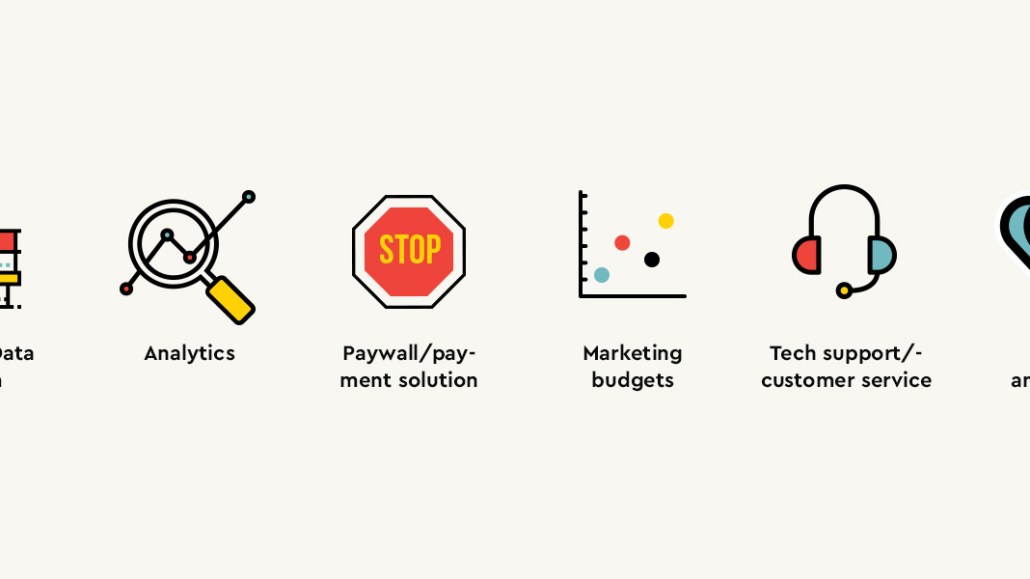
So you want to be in the subscriptions business? Before you start drafting a press release about this exciting new direction, make sure you’ve accounted for new costs that crop up when you’re chasing consumer revenue instead of advertiser budgets.
While many of these won’t be necessary at the very beginning, they start seeming essential pretty quickly, especially if you want to apply any kind of rigor to the work of acquiring and retaining customers. Here’s what you’ll need:
Customer Data Platform
In order to drive people to subscribe, you need to learn as much as you possibly can about what they are engaged with, where they are in your conversion funnel, who owns what, etc. To do that, you need to use software such as a customer data platform, which allows publishers to better understand and segment their audiences.
Cost: These run anywhere from $50,000 to $250,000 per year. Fancy enterprise-level implementations will cost over a million dollars per year.
Paywall/payment solution
Does your content management system allow you to block off content, or take credit card payments, or distinguish your paying visitors from non-paying ones? Well, if it doesn’t, you’ll need something that does.
Cost: Though these vary in sophistication and cost, popular solutions can run upwards of $70,000 per year.
Analytics
Who’s going to segment, digest and pore over all the data that you get about cart abandonment, what kinds of content drives the best conversions, and how best to move traffic around your site? While an audience development team can handle this work at the beginning, this is at least one full-time job you’ll need to add to your headcount. And that’s after you’ve ensured your analytics and CDP solutions are implemented correctly.
Cost: Data analyst salaries start at $57,000, plus benefits, according to Glassdoor; data scientists, who are vital for unearthing insights about your audience, can cost more than twice that.
Marketing budgets
Customer acquisition costs are often the biggest line items on any direct-to-consumer brand’s budget. That can mean handing ad inventory on one’s own sites over to house ads, or spending money on Facebook ads. And any successful marketing operation has a firm understanding of things like lifetime customer value, of course. But your expensive analytics team probably has that covered.
Cost: Depends
Tech support/customer service
The only thing worse than unhappy customers are unhappy customers who have to wait hours, or even days, for responses to their grievances. Media might be different from lots of other industries, but customers are customers, and they expect prompt replies.
Customer service people can sometimes pull double duty as tech support too, but that can require steady, sustained training and support: The path to fixing a bug in one’s mobile app could vary from Android phone to Android phone, and the issues in OTT vary depending on the platform.
Cost: The median salary for customer service reps is $35,000.
Hearts and minds
One of the biggest costs may involve workplace political capital. Shifting priorities toward subscription revenue affects every level of a publisher’s organization, and getting a newsroom interested in limiting the size of their audience, or convincing a head of sales that their work is still valuable is just as important as having the right tools. Plus, getting people involved helps save money.
“It helps you avoid cost if you don’t have the internal pressure [to grow immediately],” one executive at a large newspaper publisher says.
Cost: Priceless
More in Media

A timeline of the major deals between publishers and AI tech companies in 2025
Here’s a list of all the major deals signed between publishers and AI tech companies in 2025.

No playbook, just pressure: Publishers eye the rise of agentic browsers
For the bulk of publishers, Google is, as ever, the one to watch. It’s already got agentic features within its Chrome browser, but that’s the tip of the iceberg, some say.

The biggest SEO lessons in 2025 for publishers
KPIs are changing, more AI search data is becoming available, and publishers are looking beyond search to grow their audiences and revenue.





